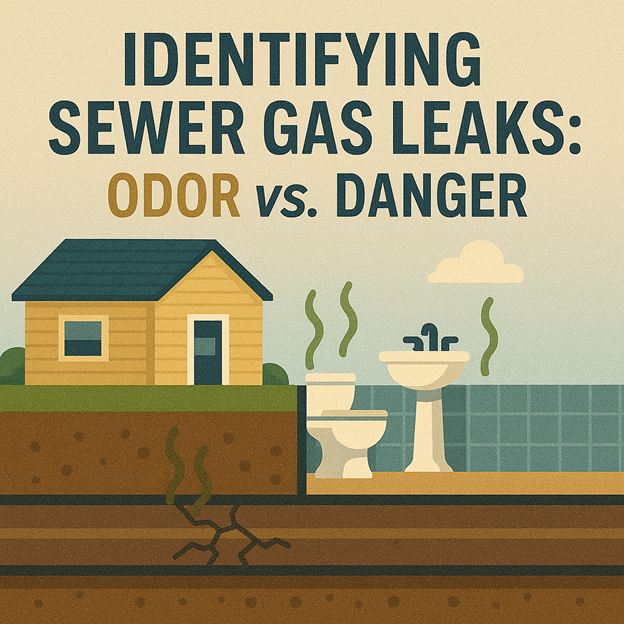It starts as a faint smell — maybe in the basement, bathroom, or laundry room. It’s unpleasant, maybe like rotten eggs, mildew, or something “off.” But is it just a bad odor, or could it be something hazardous? In Fort Wayne homes, especially older ones with aging plumbing systems, sewer gas leaks are more than just a nuisance — they’re a real health and safety concern.
Understanding the difference between an occasional musty smell and a true gas leak can help protect your family’s health, your home’s value, and your peace of mind.
1. What Is Sewer Gas?
- Sewer gas is a mix of gases released during the decomposition of organic waste in your plumbing and sewer systems
- Main components include:
- Hydrogen sulfide (H2S): The gas responsible for the classic “rotten egg” smell
- Methane: Flammable and potentially explosive in high concentrations
- Ammonia, carbon dioxide, nitrogen, and bacteria
- Normally, these gases are safely vented out of your home through your plumbing vent stack
- Problems arise when leaks, blockages, or dry traps allow these gases to escape indoors
2. How to Recognize a Sewer Gas Leak
Odor is the first warning sign, but it’s not the only one.
Common Symptoms:
- Persistent smell of rotten eggs, must, or mildew — especially near drains or in the basement
- Gurgling noises in toilets or drains, indicating pressure imbalance or venting problems
- Unusual headaches, nausea, fatigue, or dizziness — symptoms can mimic minor flu or carbon monoxide exposure
- Visible sewer flies or an increase in insect activity near drains
- Water stains or corrosion around pipe joints or vent stacks
3. Health Risks of Prolonged Exposure
- Short-term exposure to sewer gas can cause eye irritation, coughing, headaches, and nausea
- Chronic exposure — especially in poorly ventilated homes — can lead to more serious symptoms including memory problems, breathing issues, and even loss of consciousness
- Methane is an asphyxiant and can displace oxygen in the air in enclosed spaces
- Hydrogen sulfide is toxic in high concentrations and can become deadly if it accumulates undetected in basements or crawlspaces
4. Most Common Sources of Sewer Gas in Homes
- Dry drain traps: Floor drains or unused sinks/tubs can evaporate over time, leaving an open air path from the sewer
- Cracked vent pipes: Hidden behind walls or in attics, damaged vent stacks can leak gases back into the home
- Loose toilet seals: A worn or broken wax ring can allow gases to leak at the base of a toilet
- Improperly installed plumbing: Poorly sloped pipes, missing vents, or amateur DIY repairs can create pressure issues
- Clogged or obstructed vent stacks: Leaves, debris, or ice can block rooftop vents, forcing gases back into living areas
5. How to Safely Confirm and Address the Problem
Step 1: Try the Smell Test
- Pinpoint the source by sniffing around drains, toilets, laundry rooms, and basement vents
- Use a flashlight to inspect under sinks and around floor drains
Step 2: Fill Dry Traps
- Pour water into any unused drain weekly (especially floor drains and guest bathrooms)
- Add a tablespoon of mineral oil to slow evaporation
Step 3: Call a Professional
- AAA Sewer Service offers smoke testing to find hidden leaks in your vent system
- Camera inspections can detect pipe cracks, misalignments, or sewer line blockages
- Licensed plumbers can reseal toilets, repair damaged vent stacks, or correct improper installations
6. Why Sewer Gas Leaks Are More Common in Fort Wayne
- Fort Wayne’s wide range of home ages — from historic bungalows to mid-century ranches — means a variety of aging pipe materials and configurations
- Seasonal humidity, freeze-thaw cycles, and storm drain overloads increase pressure on plumbing infrastructure
- Many homes were built before modern ventilation codes were adopted — making older systems more susceptible to odor and leakage issues
Bonus Tip: Install a Drain Trap Primer
- A primer automatically refills rarely used drains with water to prevent gas leakage
- Ideal for vacation homes, basements, or utility rooms
- Can be connected to nearby appliances like washing machines or water softeners
Fort Wayne Fact:
The majority of homes built before 1975 in Fort Wayne were constructed with cast iron or galvanized vent stacks — both of which can rust, crack, or separate over time, leading to hidden sewer gas leaks.
Don’t Ignore the Smell — Trust Your Nose
If something smells “off,” don’t brush it off. Sewer gas is more than a bad odor — it’s a warning sign from your home. Whether it’s a simple floor drain fix or a deeper ventilation issue, AAA Sewer Service can diagnose and repair sewer gas leaks quickly, safely, and permanently.
📞 Call AAA Sewer Service at (260) 456-6930
🌐 Visit our website: www.aaasewerservice.com

